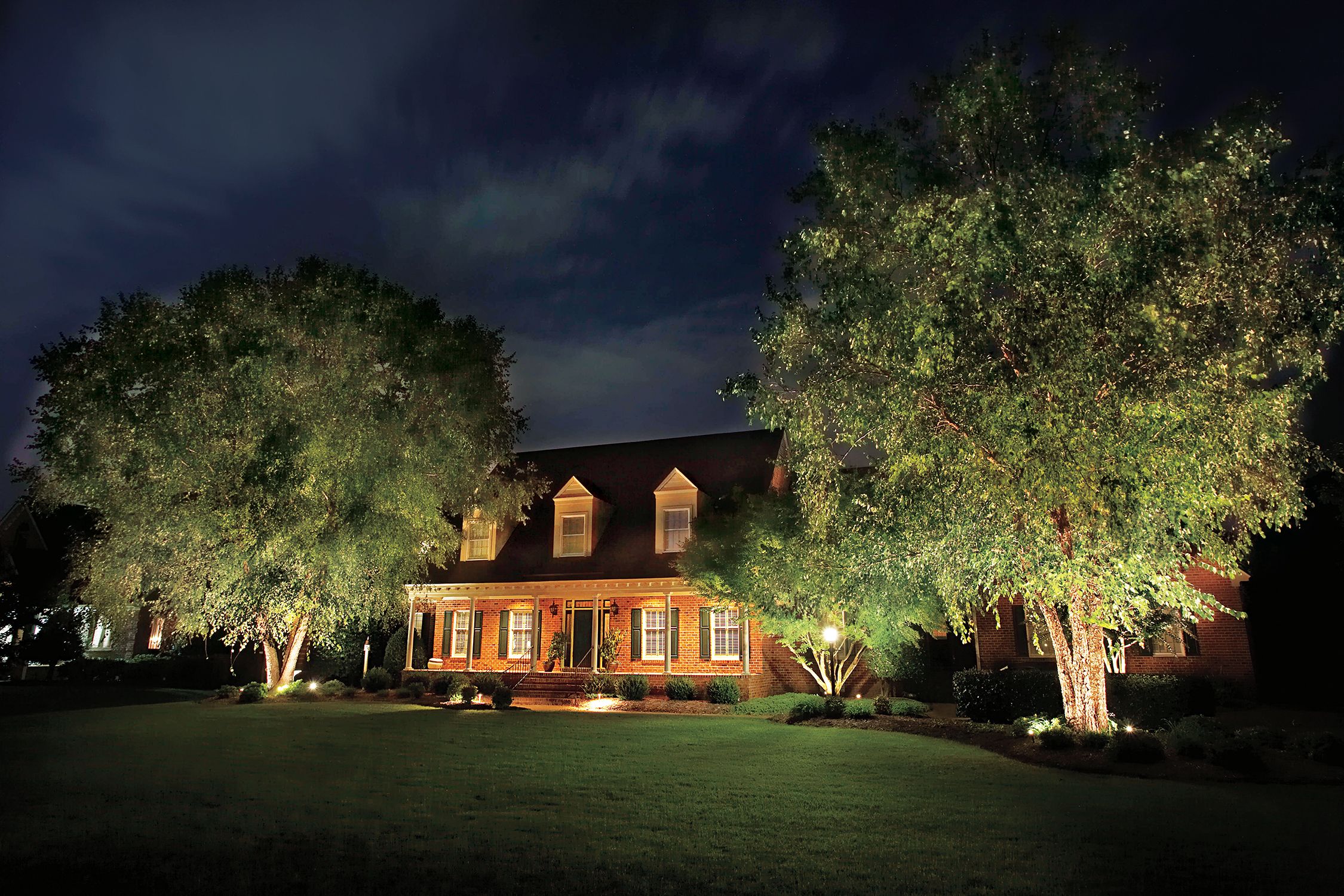You’ve pulled out all the stops to make your house and yard look first-rate. So why let that hard work disappear at nightfall? With a flick of a switch and some strategically placed landscape lighting, you can roll back the darkness and put it all on display.
This guide will walk you through everything you need to know about landscape lighting, from understanding the basics to implementing advanced design techniques.
Understanding Landscape Lighting
Landscape lighting involves more than just placing a few lights around your yard. The goal is to create a balanced, aesthetically pleasing nighttime environment that extends your living space outdoors and showcases your property’s best features.
Most modern landscape lighting systems use low-voltage power, which is safer and more cost-effective than traditional 120-volt systems. Low-voltage systems operate on 12 volts, stepped down from your home’s standard electrical supply using a transformer.
This setup allows for greater flexibility in design and easier installation, making it possible to achieve a wide range of lighting effects, from subtle washes of light on walls to dramatic spotlighting of trees and architectural elements.
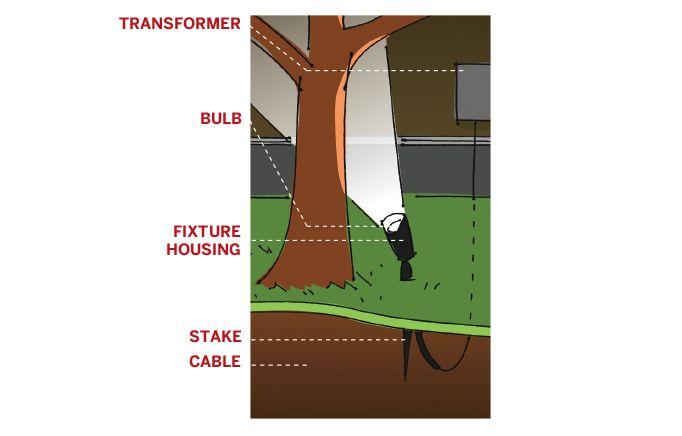
Planning Your Landscape Lighting Design
Effective landscape lighting design requires careful planning and consideration of your property’s unique features. A well-thought-out plan will ensure that your lighting enhances your home’s architecture, highlights key landscape elements, and creates the desired ambiance.
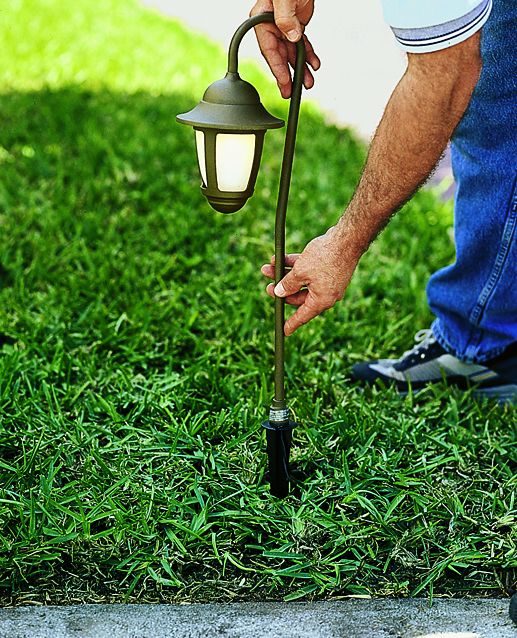
Mapping Out Your Exterior Lights
Begin by creating a detailed map of your property, including your home, pathways, trees, and key landscape features. This map will serve as your blueprint for placing lights. Consider the areas you want to highlight and the effects you want to achieve.
For DIY enthusiasts, Mark Piantedosi, owner of Commonwealth Landscape Lighting, recommends placing fixtures no closer than 20 feet apart. “You want pools of light to guide your eye from one plant to the next, not continuous illumination,” he advises.
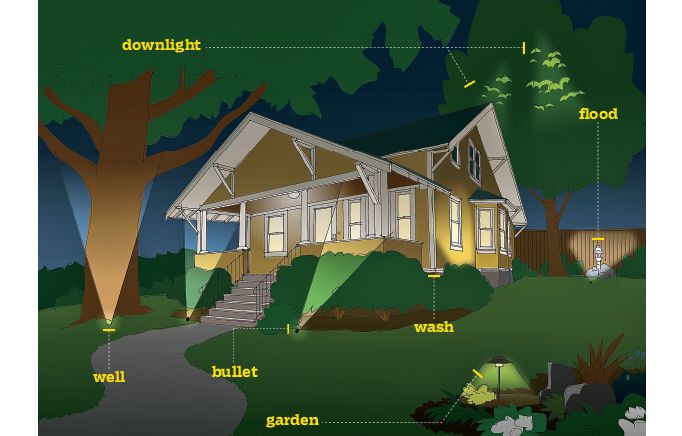
Highlighting Architectural Features
When illuminating your home’s facade, use a combination of techniques to create depth and interest. Fit bullet lights with bulbs that have 12-degree beam spreads, and aim them at the corners of your house or architectural details. Use softer wash lights to fill in the space between these focused beams. This layered approach will accentuate your home’s best features while providing overall illumination.
Illuminating Trees and Plants
Trees and plants can become stunning focal points in your nighttime landscape. For trees less than 20 feet tall, two 20-watt uplights are usually sufficient. Larger trees may require three to five uplights of 35 to 50 watts each. When uplighting trees, be sure to illuminate both the trunk and the canopy to avoid a “floating” effect.
For planting beds, use garden lights to create pools of illumination that guide the eye from one plant to the next. This technique adds depth and dimension to your garden after dark.
For more outdoor-lighting design ideas, visit FX Luminaire’s “Learning Center” or consult the classic guide The Landscape Lighting Book, by Janet Lennox Moyer.
Types of Outdoor House Lighting
Landscaping lights come in a few main types. Here’s a quick primer on each of them to help you build out your plan.
Garden Lights
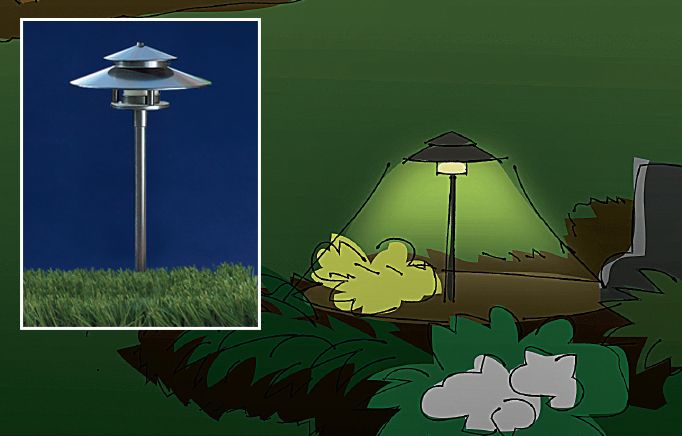
Garden lights are versatile fixtures typically mounted on 18- to 24-inch posts. They’re designed to illuminate planting beds and can also serve as pathway markers. Unlike some other landscape lights, garden lights are often decorative, with their style and finish visible as part of the overall landscape design. These lights are great for creating a soft, welcoming glow along garden paths or highlighting the edges of planting areas.
Wash Lights
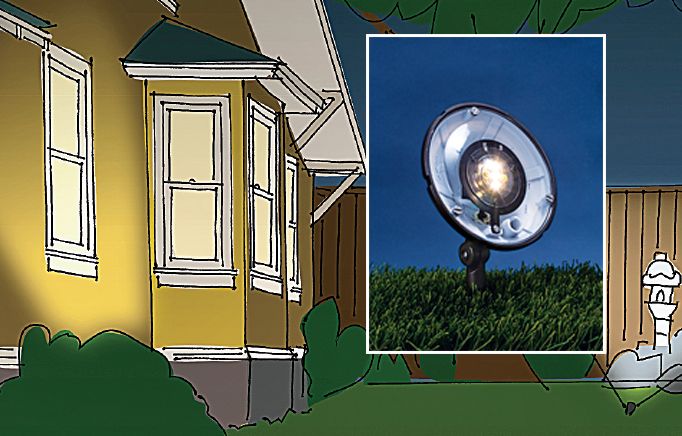
Wash lights produce a soft, diffuse light that’s ideal for illuminating flat surfaces such as facades, privacy fences, and garden walls. They create a gentle, even illumination that can make spaces feel larger and more inviting. These lights are perfect for creating a subtle, atmospheric glow across large surfaces.
Bullet Lights

Bullet lights are compact fixtures often used with narrow-beam bulbs. They’re great for precise lighting of specific features like house details, tree trunks, or garden structures. Their focused beam allows for dramatic highlighting of key elements in your landscape. These lights are ideal for creating contrast and depth in your lighting design.
Well Lights
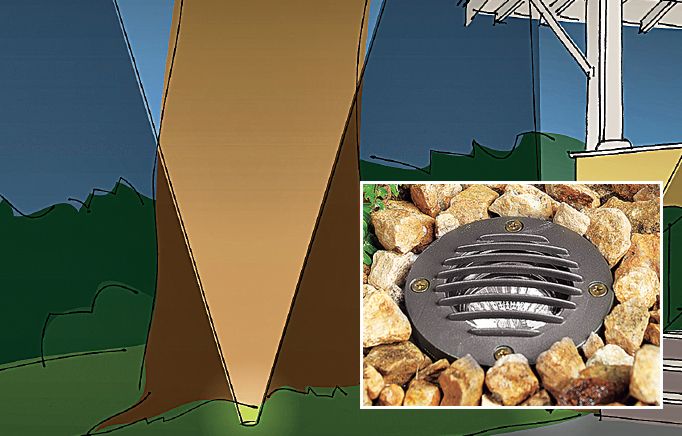
Well lights are installed in the ground with the bulb housed in a waterproof casing. They provide illumination without the fixture itself being visible, making them perfect for uplighting the underside of plant foliage or grazing the base of walls and facades. Well lights are excellent for creating dramatic effects and highlighting textural elements in your landscape.
Downlights
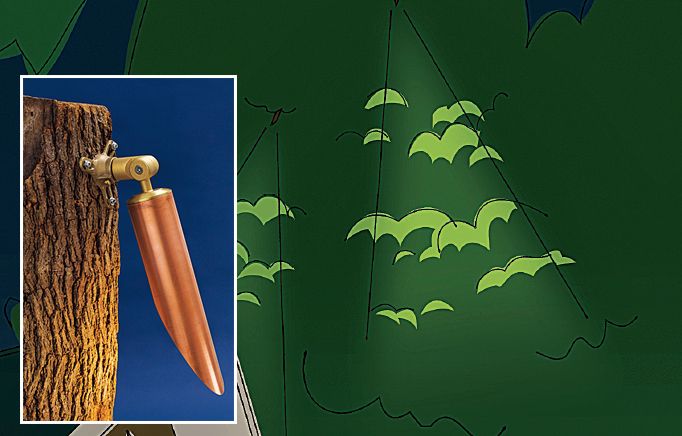
Downlights are typically mounted high in trees or on structures to cast light downward, mimicking natural moonlight. They’re often used to illuminate lawns, paths, or the tree’s own foliage. Downlights usually feature a long shroud around the bulb to eliminate side glare.
Flood Lights
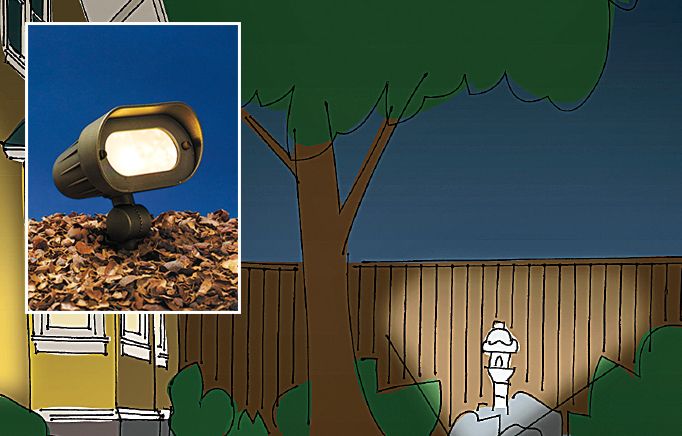
Flood lights cast a wide beam of light, typically 40 degrees or more, and are brighter than wash lights. They’re used sparingly to illuminate large areas like tall trees or wide house facades. A collar on the fixture helps minimize side glare. Flood lights are powerful tools for creating broad swaths of light in your landscape design.
Choosing the Right Bulbs
Picking the right bulbs for your landscape lighting will help you achieve the desired effect and ensure energy efficiency. The two main types of bulbs used in landscape lighting are LED and halogen.
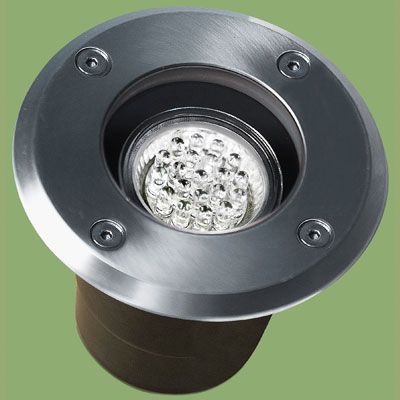
LED vs. Halogen
LED (Light Emitting Diode) bulbs have become increasingly popular in landscape lighting due to their numerous benefits:
- Longevity: LED lights can last up to 40,000 hours, or about 20 years of regular use, compared to just two years for halogen bulbs.
- Energy efficiency: LEDs use one to 11 watts of power, versus 20 to 60 watts for halogens, resulting in lower operating costs.
- Durability: LEDs are more resistant to shock and vibration than halogen bulbs.
- Lower heat emission: LEDs are generally safer and reduce the risk of damage to nearby plants.
Though LEDs have a higher initial cost compared to halogen bulbs, the long-term savings in energy and replacement costs often make them more economical over time.
Color Temperature Considerations
Color temperature, measured in Kelvins (K), affects the mood and appearance of your landscape lighting. For a warm, inviting atmosphere similar to traditional incandescent lighting, look for bulbs with a color temperature around 2,700K to 3 000K. Cooler temperatures (4,000K and above) create a brighter, more moonlit effect but can appear harsh in some settings.
Many early LED bulbs had a cool blue light with a color temperature around 6,000K. When choosing LEDs, look for warm-color options around 3,000K for a more natural light.
Lumens and Brightness
Lumens measure the total amount of visible light emitted by a bulb. When selecting bulbs, consider the lumens output to ensure you’re getting enough brightness for your intended purpose. As a general guide:
- Path lights: 100-200 lumens
- Landscape accent lights: 50-300 lumens
- Flood lights: 700-1300 lumens
Brighter isn’t always better when it comes to landscape lighting. The goal is to create a balanced, pleasing effect rather than to illuminate your yard like a sports field.
Low-Voltage vs. High-Voltage Lighting Systems
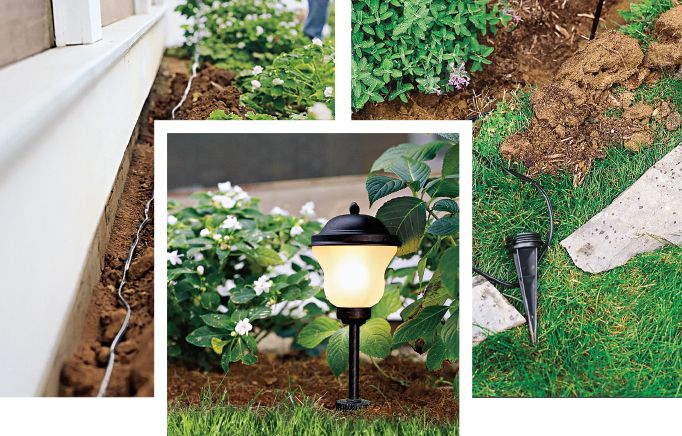
When it comes to landscape lighting, low-voltage systems have become the standard for most residential applications, and offers numerous advantages.
Benefits of Low-Voltage Lighting
Low-voltage landscape lighting systems, which typically operate at 12 volts, offer several advantages over traditional 120-volt systems:
- Safety: The lower voltage significantly reduces the risk of electrical shock, making these systems generally safer to install and maintain.
- Cost-effectiveness: Low-voltage systems are typically less expensive to install and operate than high-voltage alternatives.
- Flexibility: These systems allow for easier adjustments and additions to your lighting design over time.
- Energy efficiency: Low-voltage lights consume less power, leading to lower energy bills.
- DIY-friendliness: Many homeowners can install basic low-voltage systems themselves, saving on professional installation costs.
Components of a Low-Voltage System
A typical low-voltage landscape lighting system consists of several key components:
- Transformer: This device steps down the 120-volt household current to a safer 12 volts. The size of the transformer should be based on the total wattage of all lights in the system, multiplied by 1.25 to allow for future expansion.
- Cables: Low-voltage cables carry the current from the transformer to the light fixtures. These cables must be buried at least six inches deep.
- Fixtures: These include the various types of lights discussed earlier, such as path lights, spotlights, and well lights.
- Bulbs: The choice of bulb determines the brightness, color temperature, and energy efficiency of each light.
- Controls: Timers, photocells, or smart home integration systems can automate your landscape lighting.
When planning your system, you’ll typically want to aim for uniform brightness across all fixtures. This can be achieved by using a hub system: run a 10-gauge cable to a waterproof junction box, then branch out with equal lengths of 12-gauge cable to the fixtures. Keep cable runs under 50 feet to maintain consistent power delivery.
Landscape Lighting Installation Tips and Techniques
Installing landscape lighting can be a rewarding DIY project for many homeowners. However, it’s important to understand the process and know when it might be better to call in a professional.
DIY Installation Guide
If you’re comfortable with basic electrical work and have a well-planned design, you can install a simple low-voltage landscape lighting system yourself. Here’s a basic guide:
- Start with a plan: Map out your lighting design, including fixture locations and cable routes.
- Install the transformer: Mount it near a GFCI-protected outdoor outlet. If you don’t have one, hire an electrician to install it.
- Lay out the main cable: Run a 10-gauge cable from the transformer to your planned lighting locations.
- Install fixtures: Place your lights according to your plan. Most come with ground stakes for easy installation.
- Connect the lights: Attach the fixtures to the main cable using the connectors provided with your lighting kit.
- Bury the cable: Dig shallow trenches (at least 6 inches deep) and bury the cable.
- Set up controls: Install timers or other control systems as desired.
- Test and adjust: Turn on your system and make any necessary adjustments to fixture positioning or brightness.
When To Hire a Professional
While many homeowners can handle basic landscape lighting installation, there are situations where it’s best to hire a professional, such as:
- Complex designs with many fixtures or zones
- Installation in difficult terrain or around valuable landscaping
- Integration with existing electrical or home automation systems
- If you’re uncomfortable working with electrical systems
Professional installers bring expertise in design, technical knowledge, and access to a wider range of high-quality fixtures. They can also ensure your system meets all local codes and is installed safely and efficiently.
Landscape Lighting Design Ideas
Landscape lighting can transform various outdoor spaces on your property. Here are some inspiring ideas to consider when installing landscape lighting on your property.
Creating a Welcoming Facade
Illuminating your home’s facade is one of the most impactful ways to use landscape lighting. Upward-facing bullet lights placed about a foot from the foundation can highlight attractive architectural elements such as columns, eaves, and dormers.
To achieve a balanced look, combine focused beams on key features with softer wash lighting to fill in the spaces between. This layered approach adds depth and dimension to your home’s nighttime appearance.
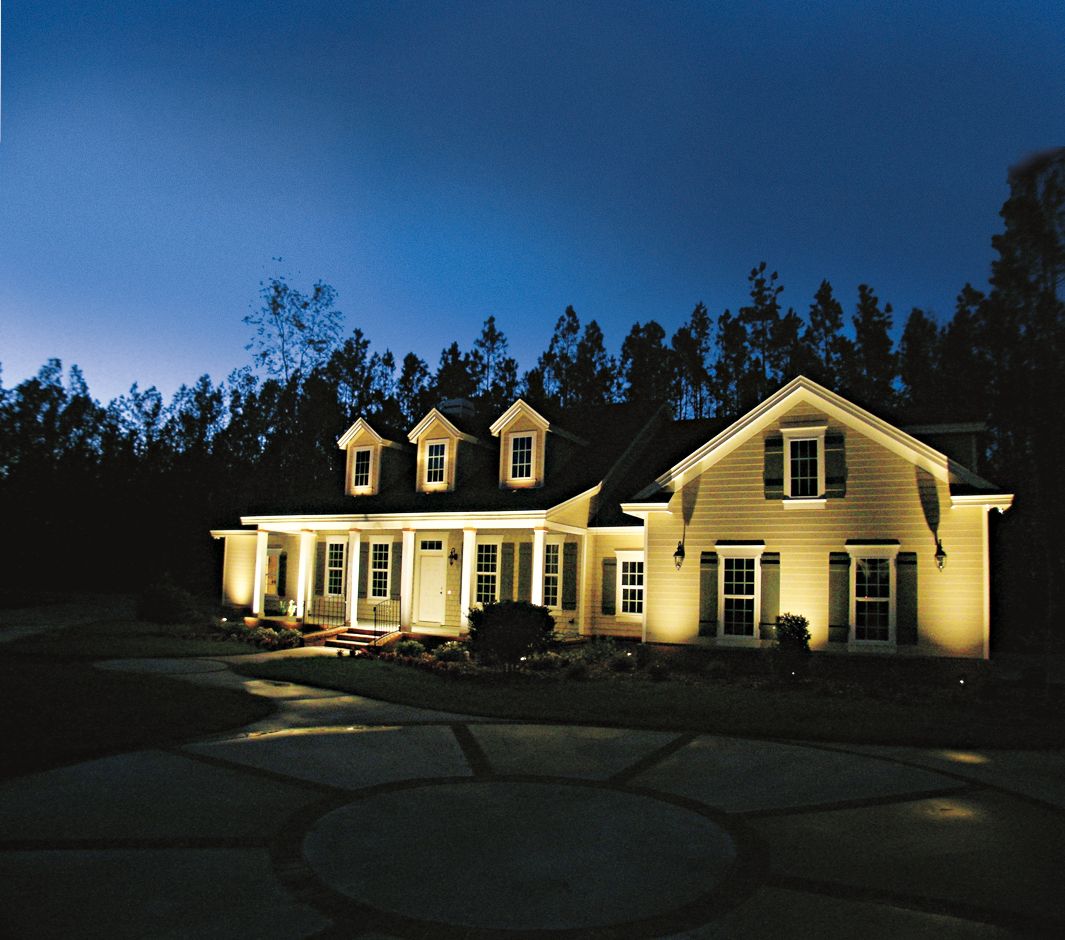
Enhancing Outdoor Living Spaces
Extend your living area into the outdoors by thoughtfully lighting patios, decks, and seating areas. Tree-mounted downlights can create a moonlit effect, casting a soft glow over these spaces.
Consider adding subtle lighting to outdoor kitchen areas, providing both ambiance and functional light for cooking and dining. Well lights around the perimeter of a patio or deck can define the space without overwhelming it with brightness.
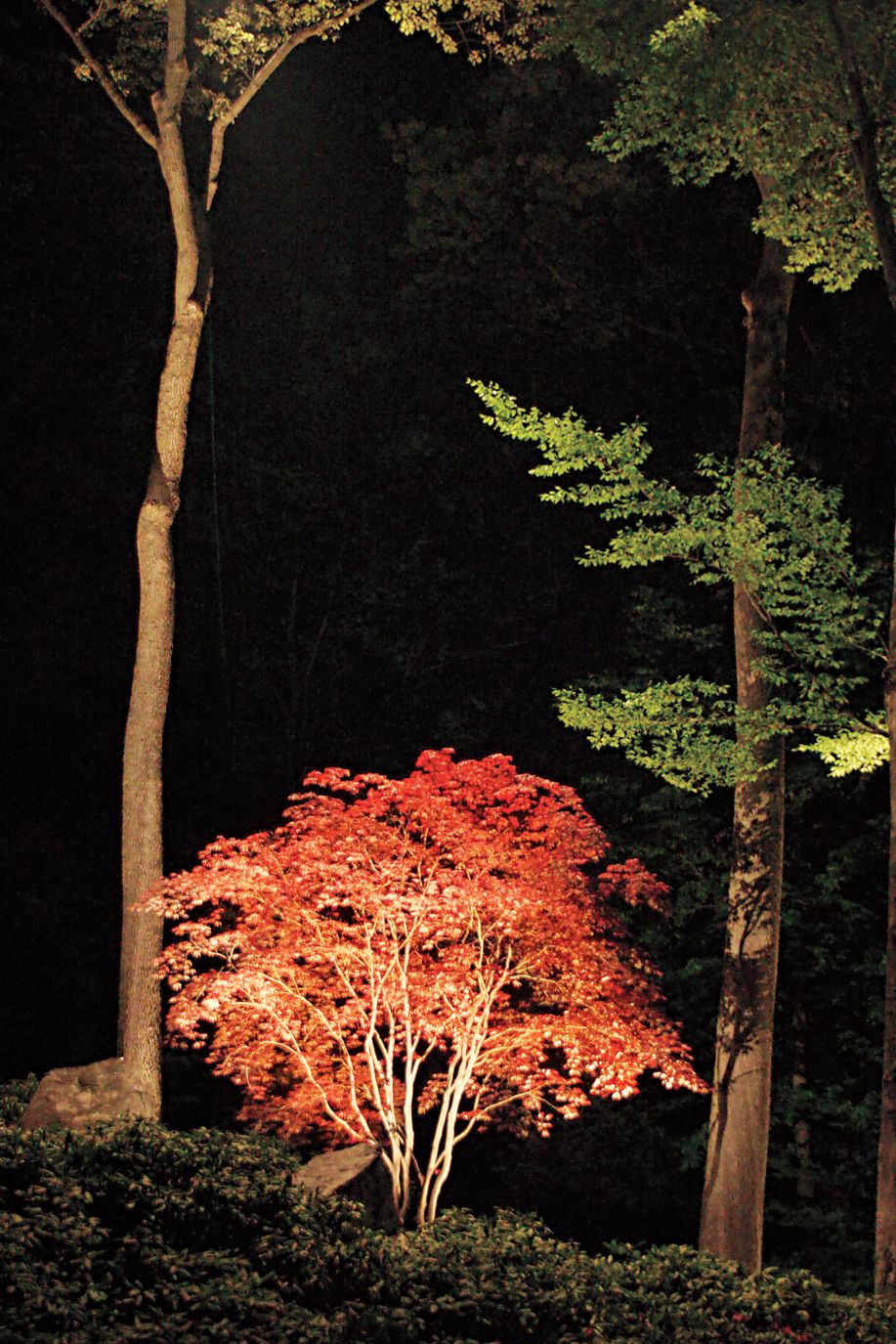

Illuminating Pathways and Driveways
Lighting walkways and driveways serves both aesthetic and safety purposes. Use path lights spaced about six to eight feet apart to guide visitors safely to your door. For a cohesive look, choose fixtures that complement your home’s architectural style.
For driveways, consider using a combination of downlighting from nearby trees and low-level path lights along the edges. This approach provides necessary illumination without creating a runway effect.
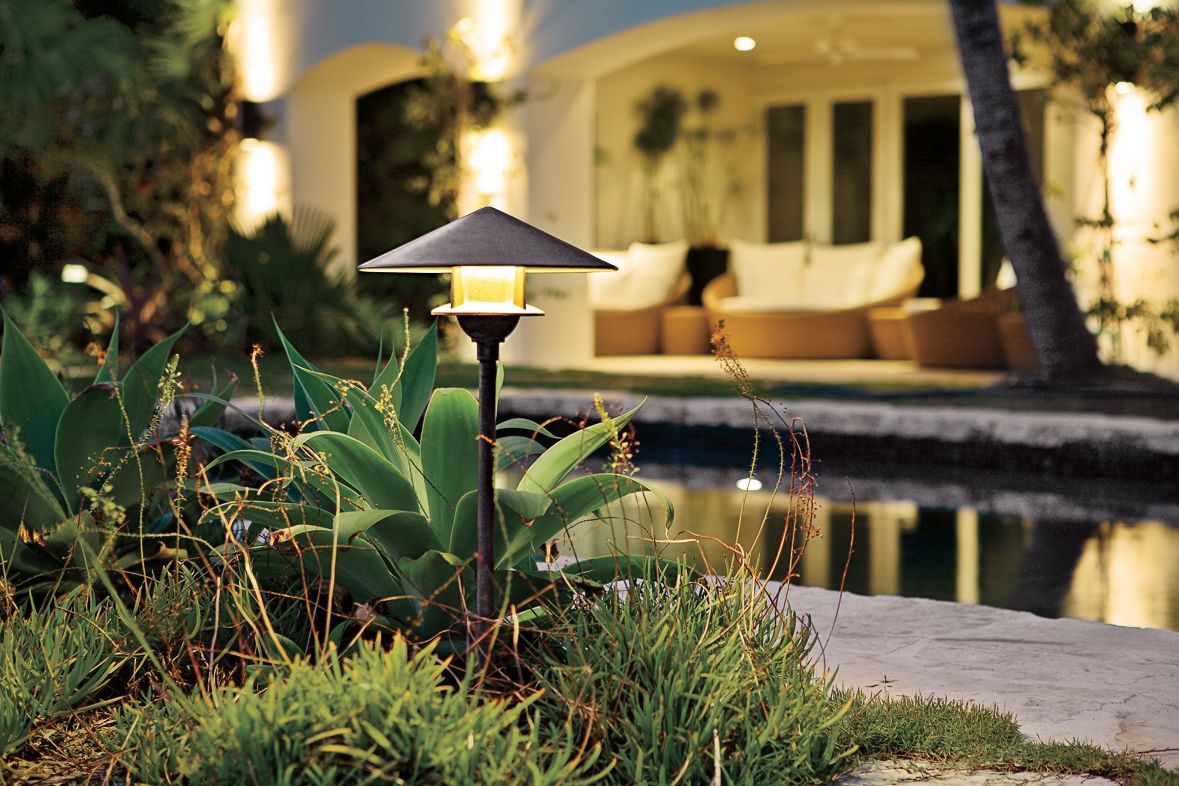
Landscape Lighting Maintenance and Troubleshooting
Proper maintenance of your landscape lighting system helps it last longer and perform better. Regular care can prevent many common issues and keep your outdoor spaces looking their best year-round.
Routine Care for Fixtures
To maintain your landscape lighting:
- Clean fixtures regularly: Remove dirt, debris, and spider webs that can accumulate on lenses and housings.
- Check for damage: Inspect fixtures, wires, and connections for signs of wear or damage, especially after severe weather.
- Trim vegetation: Keep plants from overgrowing and blocking lights or damaging wires.
- Replace bulbs proactively: Change bulbs before they burn out to prevent voltage overloads on other lights in the circuit.
- Adjust fixtures: Periodically check and adjust light positioning to account for plant growth or changes in your landscape.
Addressing Common Issues
If you encounter problems with your landscape lighting, here are some troubleshooting tips:
- Flickering lights: This could indicate loose connections or voltage issues. Check all connections and ensure your transformer is providing the correct voltage.
- Dim lights: If lights appear dimmer than usual, it could be due to voltage drop over long cable runs. Consider adding a hub system to distribute power more evenly.
- Lights not working: Check the transformer, timer settings, and individual bulbs. A single faulty connection can affect multiple lights on the same circuit.
- Corrosion: In coastal areas, salt air can corrode fixtures. Use fixtures made of corrosion-resistant materials like brass or copper in these environments.
- Water damage: Ensure all connections are waterproof and that fixtures are properly sealed against moisture intrusion.
Our Conclusion
Landscape lighting is more than just a functional addition to your garden—it’s a key component of your outdoor design that enhances the beauty, safety, and usability of your space. By understanding the basics of landscape lighting, planning a thoughtful design, and choosing the right fixtures and bulbs, you can create a stunning nighttime landscape that extends your living space and highlights your home’s best features.
